Lexus GS250 2012 Owner's Manual
Manufacturer: LEXUS, Model Year: 2012, Model line: GS250, Model: Lexus GS250 2012Pages: 914, PDF Size: 53.04 MB
Page 271 of 914
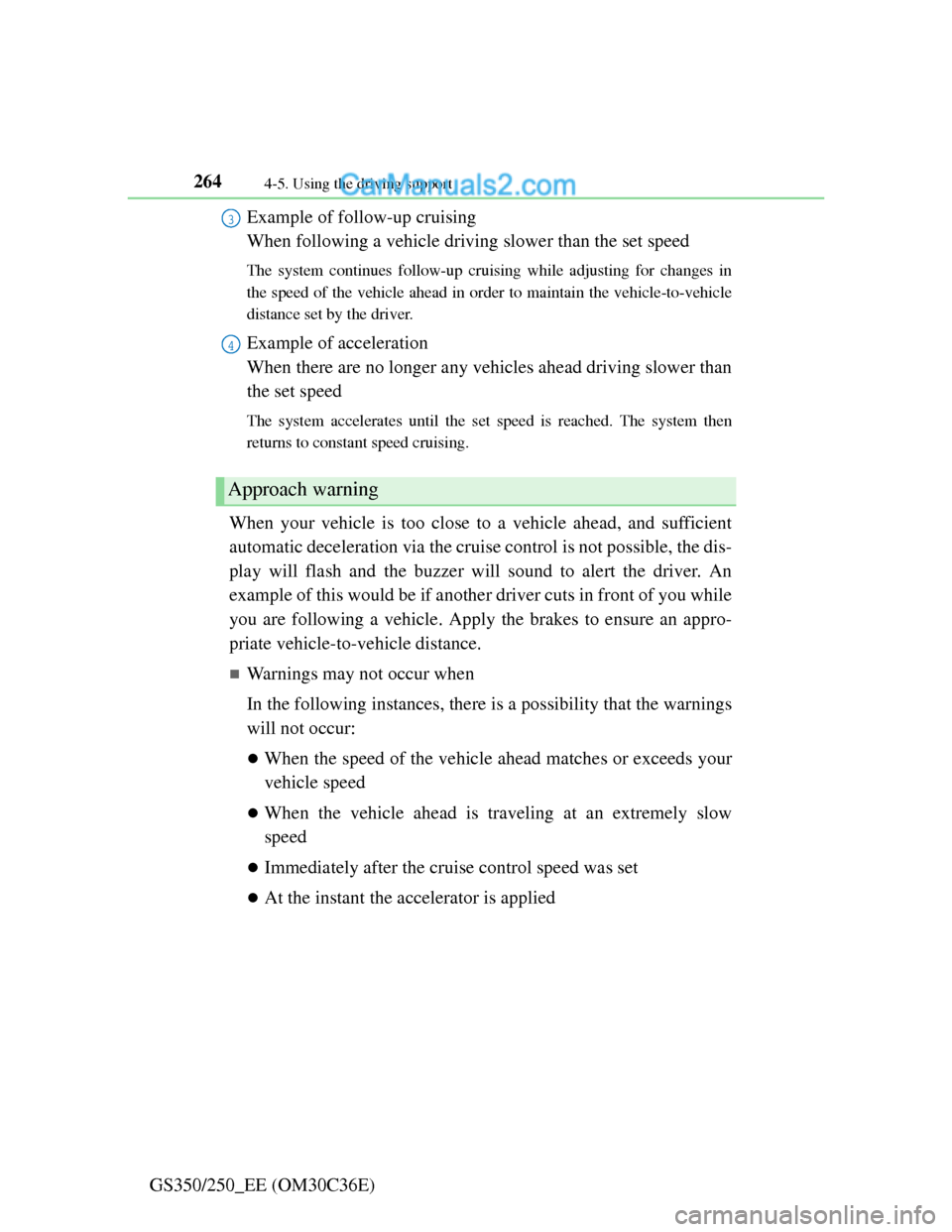
2644-5. Using the driving support
GS350/250_EE (OM30C36E)Example of follow-up cruising
When following a vehicle driving slower than the set speed
The system continues follow-up cruising while adjusting for changes in
the speed of the vehicle ahead in order to maintain the vehicle-to-vehicle
distance set by the driver.
Example of acceleration
When there are no longer any vehicles ahead driving slower than
the set speed
The system accelerates until the set speed is reached. The system then
returns to constant speed cruising.
When your vehicle is too close to a vehicle ahead, and sufficient
automatic deceleration via the cruise control is not possible, the dis-
play will flash and the buzzer will sound to alert the driver. An
example of this would be if another driver cuts in front of you while
you are following a vehicle. Apply the brakes to ensure an appro-
priate vehicle-to-vehicle distance.
Warnings may not occur when
In the following instances, there is a possibility that the warnings
will not occur:
When the speed of the vehicle ahead matches or exceeds your
vehicle speed
When the vehicle ahead is traveling at an extremely slow
speed
Immediately after the cruise control speed was set
At the instant the accelerator is applied
Approach warning
3
4
Page 272 of 914
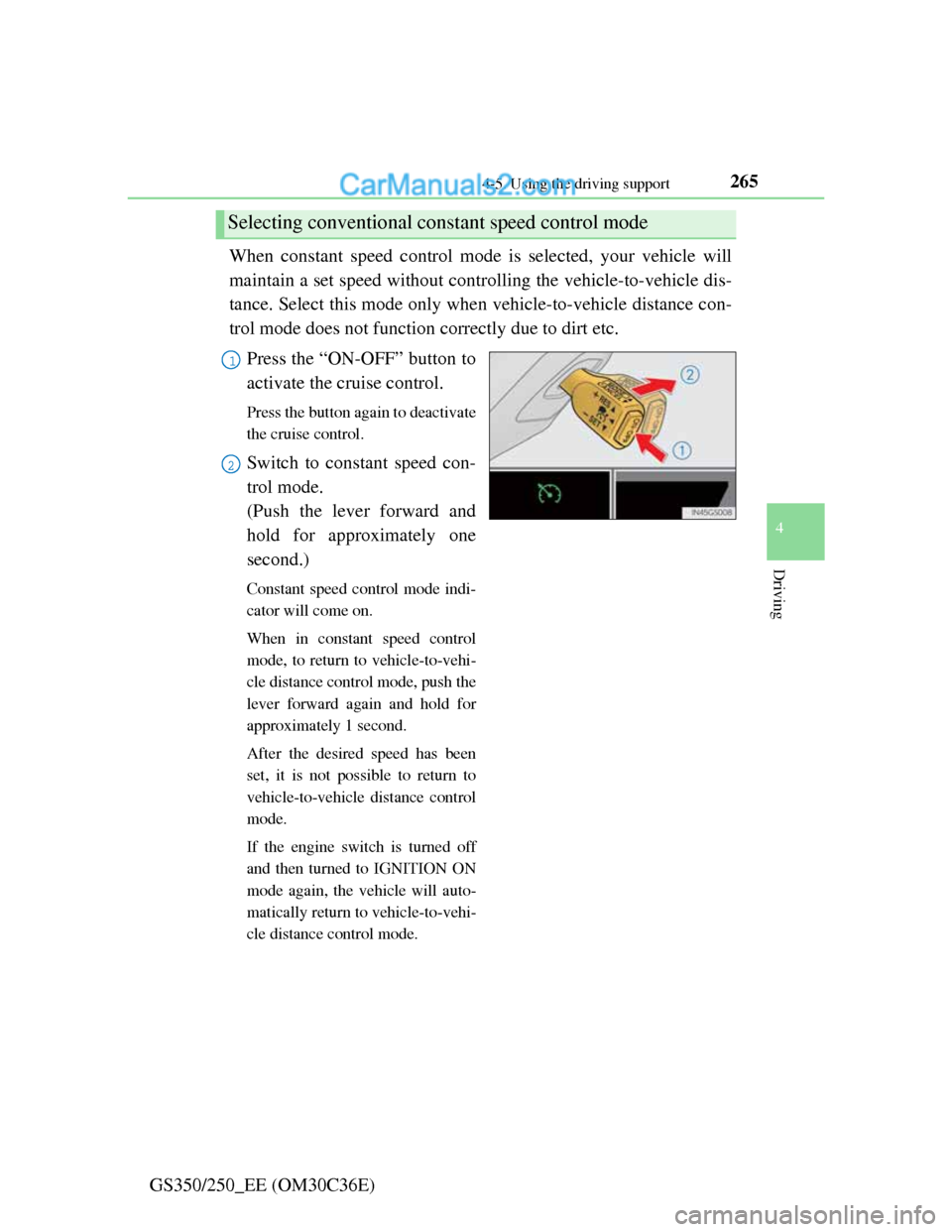
2654-5. Using the driving support
4
Driving
GS350/250_EE (OM30C36E)When constant speed control mode is selected, your vehicle will
maintain a set speed without controlling the vehicle-to-vehicle dis-
tance. Select this mode only when vehicle-to-vehicle distance con-
trol mode does not function correctly due to dirt etc.
Press the “ON-OFF” button to
activate the cruise control.
Press the button again to deactivate
the cruise control.
Switch to constant speed con-
trol mode.
(Push the lever forward and
hold for approximately one
second.)
Constant speed control mode indi-
cator will come on.
When in constant speed control
mode, to return to vehicle-to-vehi-
cle distance control mode, push the
lever forward again and hold for
approximately 1 second.
After the desired speed has been
set, it is not possible to return to
vehicle-to-vehicle distance control
mode.
If the engine switch is turned off
and then turned to IGNITION ON
mode again, the vehicle will auto-
matically return to vehicle-to-vehi-
cle distance control mode.
Selecting conventional constant speed control mode
1
2
Page 273 of 914
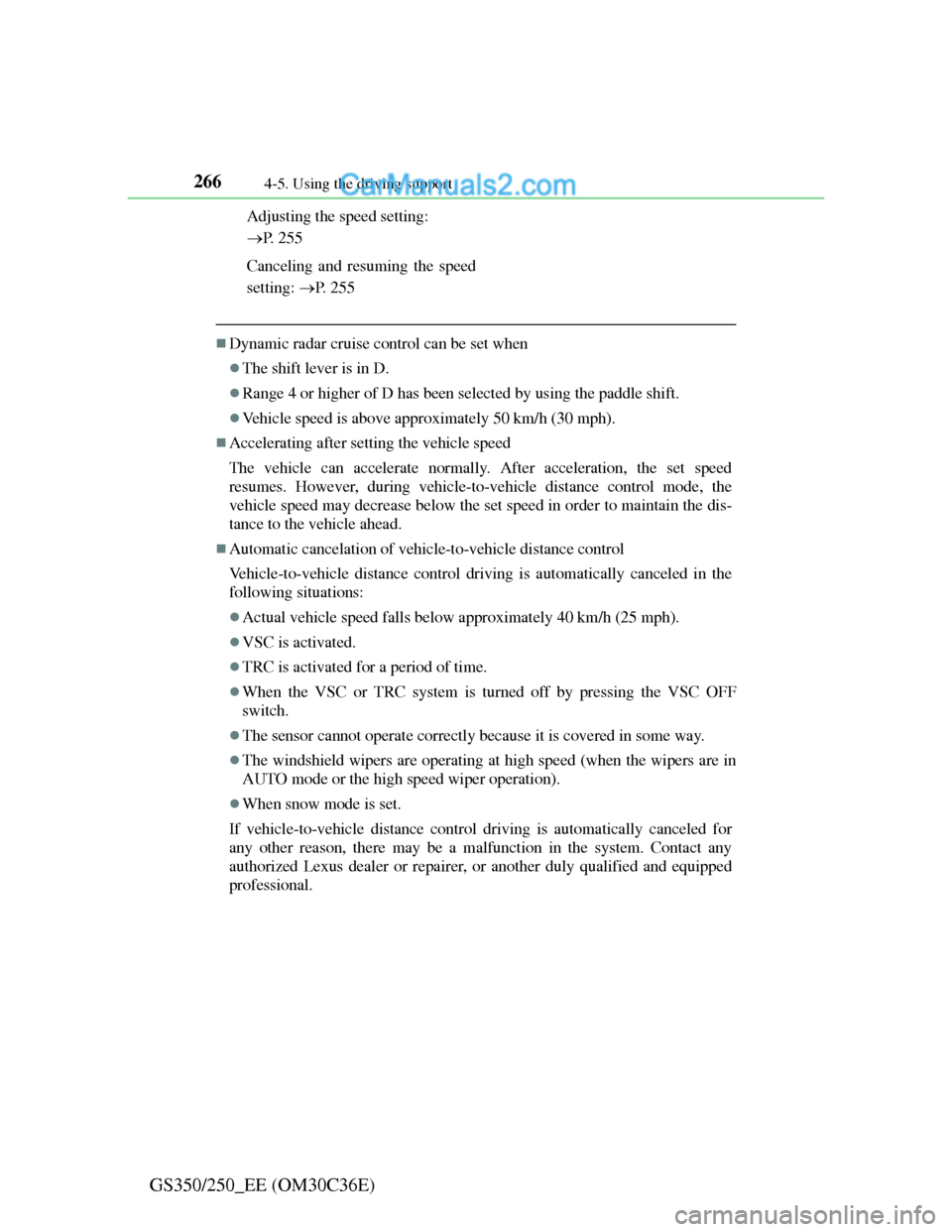
2664-5. Using the driving support
GS350/250_EE (OM30C36E)
Adjusting the speed setting:
P. 2 5 5
Canceling and resuming the speed
setting: P. 2 5 5
Dynamic radar cruise control can be set when
The shift lever is in D.
Range 4 or higher of D has been selected by using the paddle shift.
Vehicle speed is above approximately 50 km/h (30 mph).
Accelerating after setting the vehicle speed
The vehicle can accelerate normally. After acceleration, the set speed
resumes. However, during vehicle-to-vehicle distance control mode, the
vehicle speed may decrease below the set speed in order to maintain the dis-
tance to the vehicle ahead.
Automatic cancelation of vehicle-to-vehicle distance control
Vehicle-to-vehicle distance control driving is automatically canceled in the
following situations:
Actual vehicle speed falls below approximately 40 km/h (25 mph).
VSC is activated.
TRC is activated for a period of time.
When the VSC or TRC system is turned off by pressing the VSC OFF
switch.
The sensor cannot operate correctly because it is covered in some way.
The windshield wipers are operating at high speed (when the wipers are in
AUTO mode or the high speed wiper operation).
When snow mode is set.
If vehicle-to-vehicle distance control driving is automatically canceled for
any other reason, there may be a malfunction in the system. Contact any
authorized Lexus dealer or repairer, or another duly qualified and equipped
professional.
Page 274 of 914
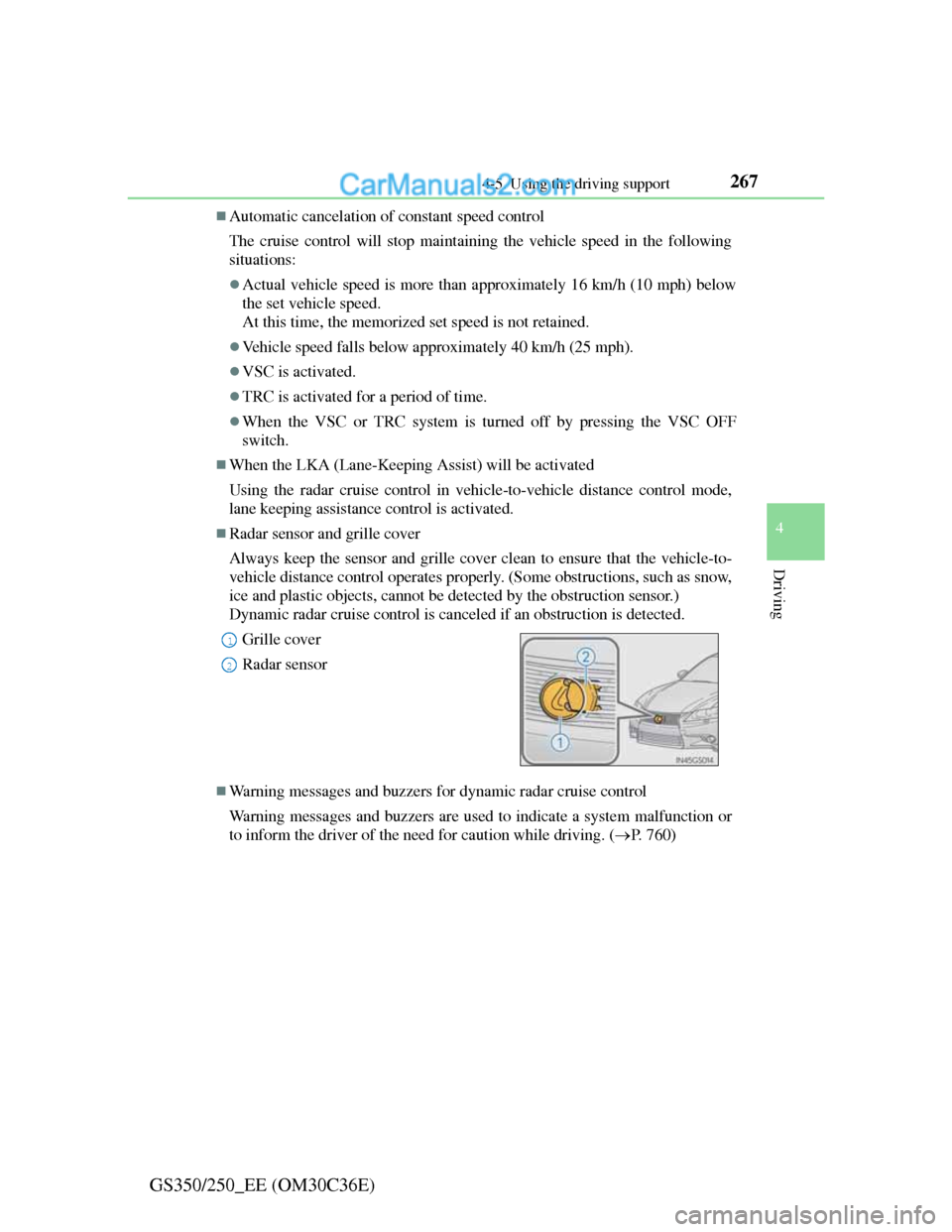
2674-5. Using the driving support
4
Driving
GS350/250_EE (OM30C36E)
Automatic cancelation of constant speed control
The cruise control will stop maintaining the vehicle speed in the following
situations:
Actual vehicle speed is more than approximately 16 km/h (10 mph) below
the set vehicle speed.
At this time, the memorized set speed is not retained.
Vehicle speed falls below approximately 40 km/h (25 mph).
VSC is activated.
TRC is activated for a period of time.
When the VSC or TRC system is turned off by pressing the VSC OFF
switch.
When the LKA (Lane-Keeping Assist) will be activated
Using the radar cruise control in vehicle-to-vehicle distance control mode,
lane keeping assistance control is activated.
Radar sensor and grille cover
Always keep the sensor and grille cover clean to ensure that the vehicle-to-
vehicle distance control operates properly. (Some obstructions, such as snow,
ice and plastic objects, cannot be detected by the obstruction sensor.)
Dynamic radar cruise control is canceled if an obstruction is detected.
Warning messages and buzzers for dynamic radar cruise control
Warning messages and buzzers are used to indicate a system malfunction or
to inform the driver of the need for caution while driving. (P. 760) Grille cover
Radar sensor
1
2
Page 275 of 914
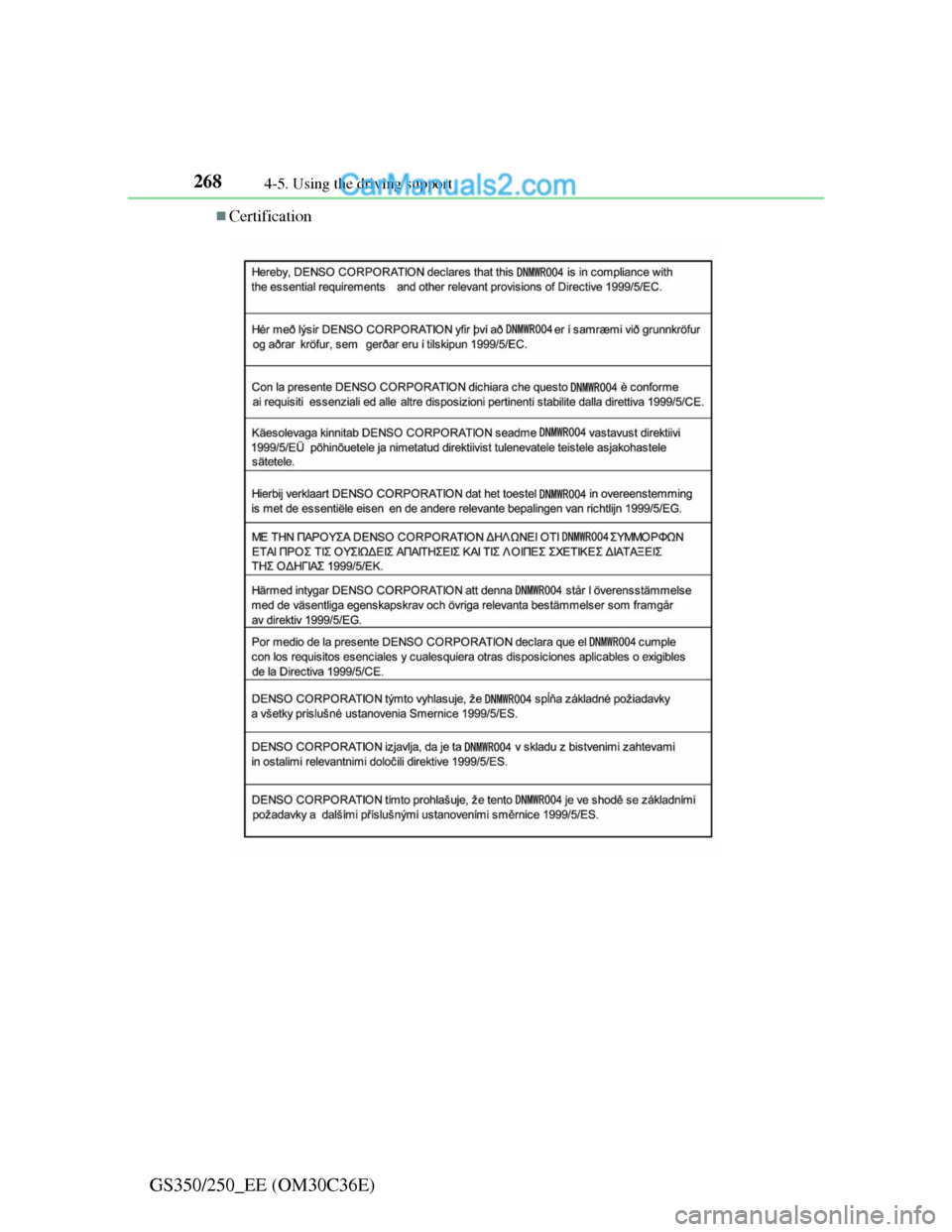
2684-5. Using the driving support
GS350/250_EE (OM30C36E)
Certification
Page 276 of 914
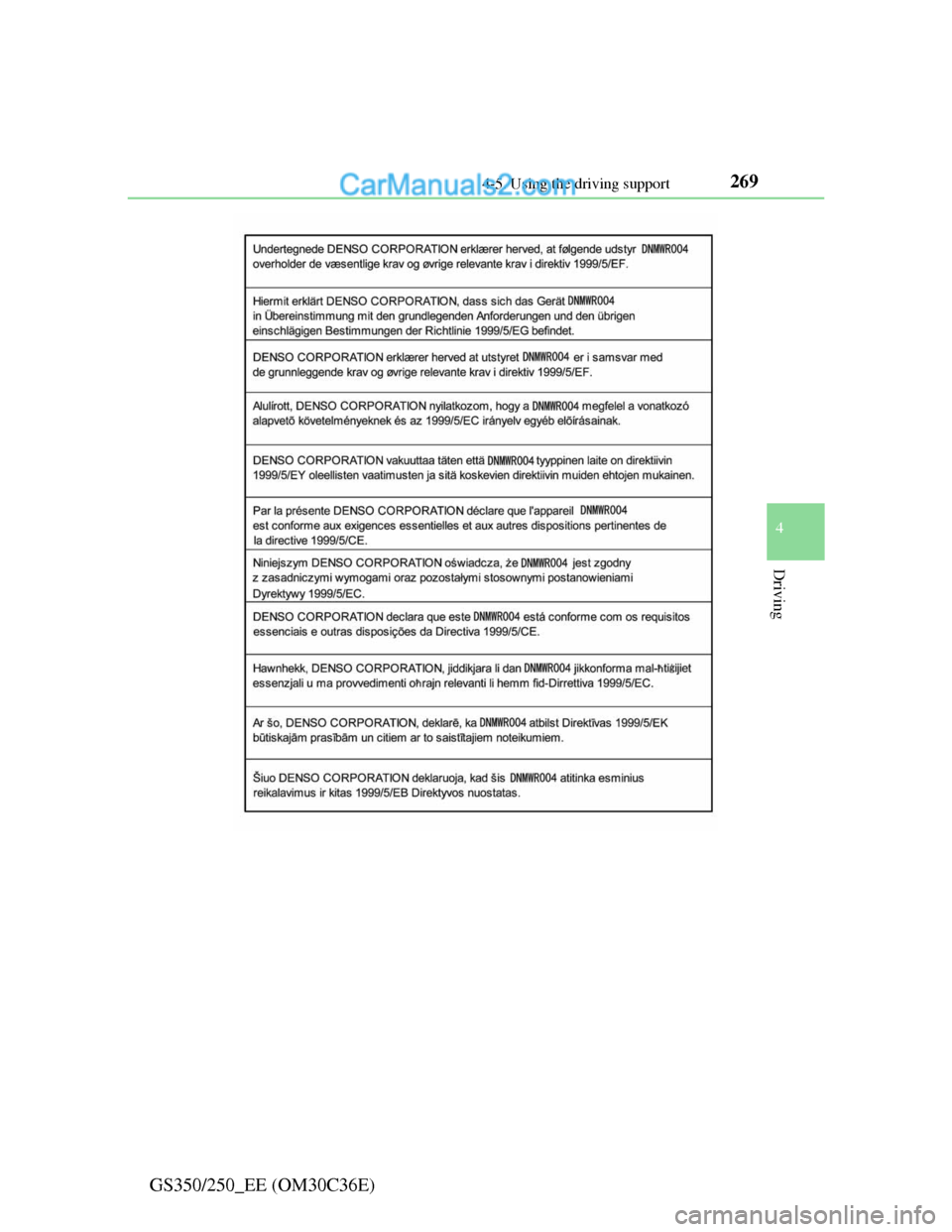
2694-5. Using the driving support
4
Driving
GS350/250_EE (OM30C36E)
Page 277 of 914
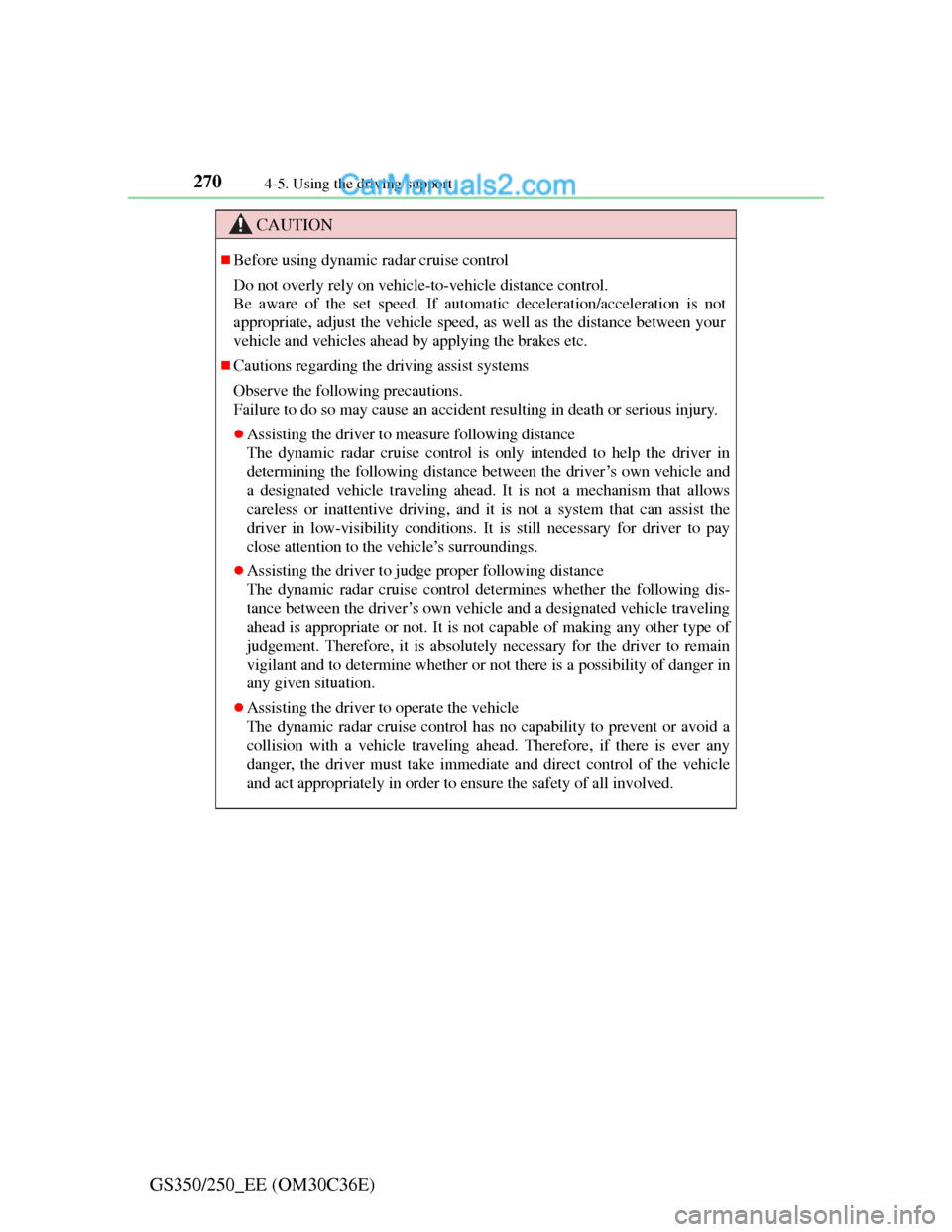
2704-5. Using the driving support
GS350/250_EE (OM30C36E)
CAUTION
Before using dynamic radar cruise control
Do not overly rely on vehicle-to-vehicle distance control.
Be aware of the set speed. If automatic deceleration/acceleration is not
appropriate, adjust the vehicle speed, as well as the distance between your
vehicle and vehicles ahead by applying the brakes etc.
Cautions regarding the driving assist systems
Observe the following precautions.
Failure to do so may cause an accident resulting in death or serious injury.
Assisting the driver to measure following distance
The dynamic radar cruise control is only intended to help the driver in
determining the following distance between the driver’s own vehicle and
a designated vehicle traveling ahead. It is not a mechanism that allows
careless or inattentive driving, and it is not a system that can assist the
driver in low-visibility conditions. It is still necessary for driver to pay
close attention to the vehicle’s surroundings.
Assisting the driver to judge proper following distance
The dynamic radar cruise control determines whether the following dis-
tance between the driver’s own vehicle and a designated vehicle traveling
ahead is appropriate or not. It is not capable of making any other type of
judgement. Therefore, it is absolutely necessary for the driver to remain
vigilant and to determine whether or not there is a possibility of danger in
any given situation.
Assisting the driver to operate the vehicle
The dynamic radar cruise control has no capability to prevent or avoid a
collision with a vehicle traveling ahead. Therefore, if there is ever any
danger, the driver must take immediate and direct control of the vehicle
and act appropriately in order to ensure the safety of all involved.
Page 278 of 914
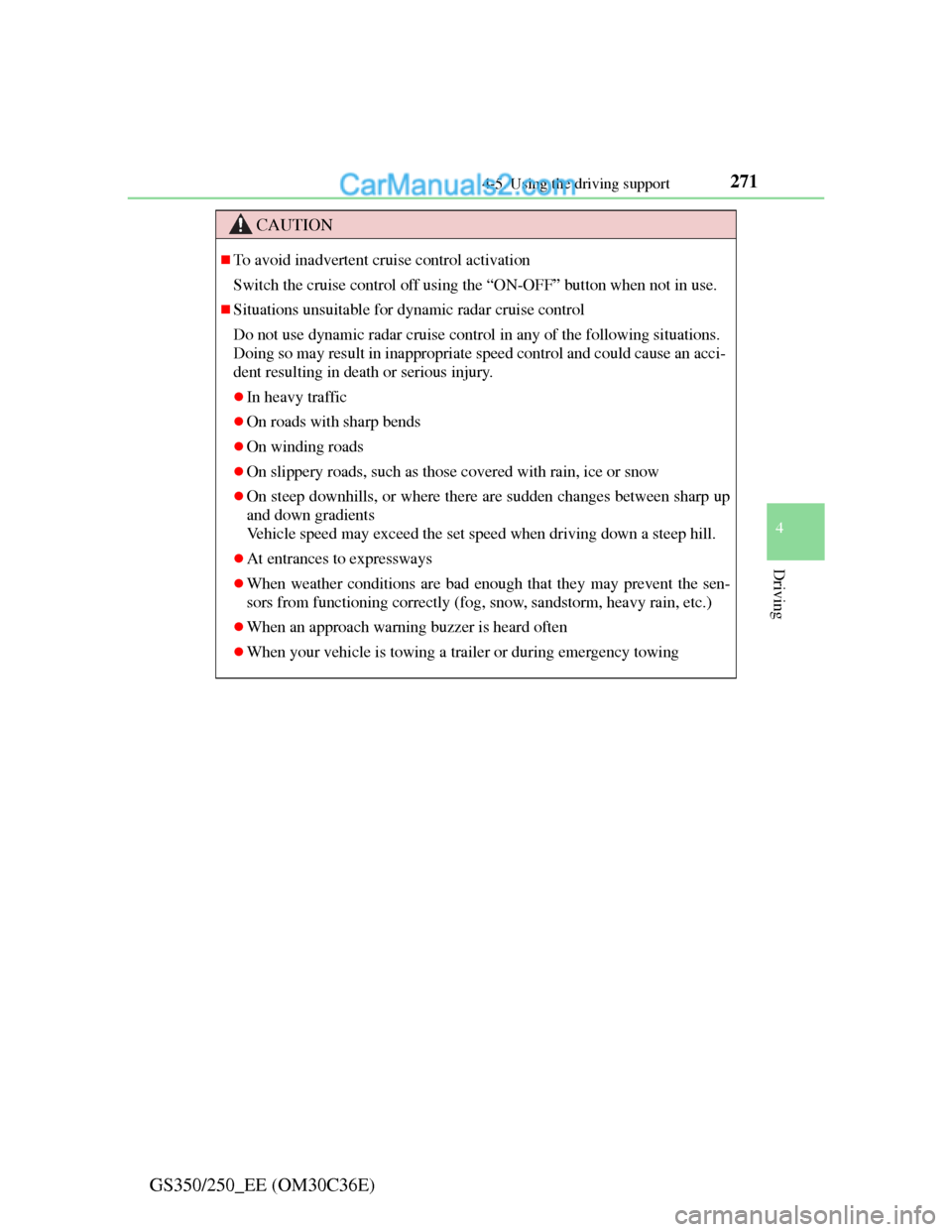
2714-5. Using the driving support
4
Driving
GS350/250_EE (OM30C36E)
CAUTION
To avoid inadvertent cruise control activation
Switch the cruise control off using the “ON-OFF” button when not in use.
Situations unsuitable for dynamic radar cruise control
Do not use dynamic radar cruise control in any of the following situations.
Doing so may result in inappropriate speed control and could cause an acci-
dent resulting in death or serious injury.
In heavy traffic
On roads with sharp bends
On winding roads
On slippery roads, such as those covered with rain, ice or snow
On steep downhills, or where there are sudden changes between sharp up
and down gradients
Vehicle speed may exceed the set speed when driving down a steep hill.
At entrances to expressways
When weather conditions are bad enough that they may prevent the sen-
sors from functioning correctly (fog, snow, sandstorm, heavy rain, etc.)
When an approach warning buzzer is heard often
When your vehicle is towing a trailer or during emergency towing
Page 279 of 914
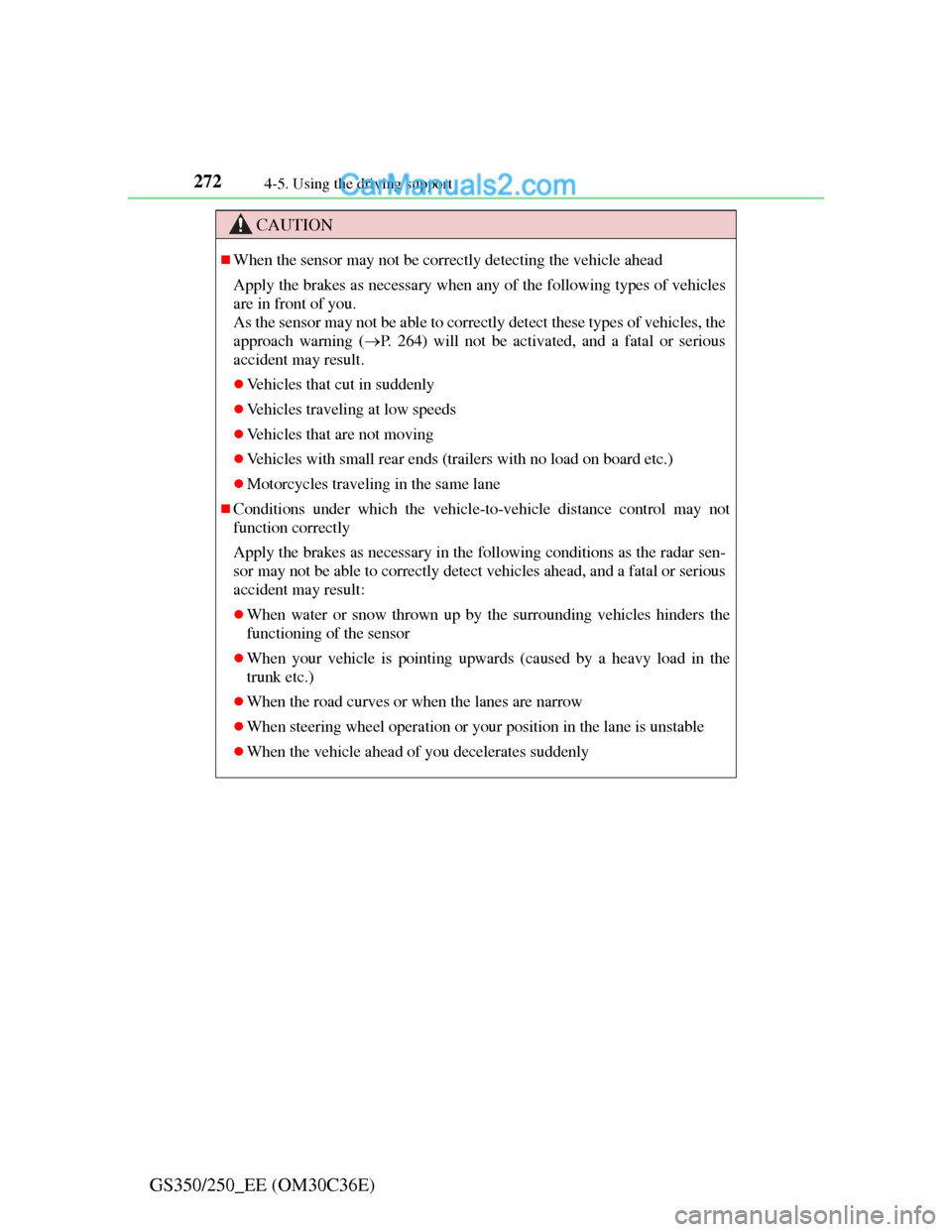
2724-5. Using the driving support
GS350/250_EE (OM30C36E)
CAUTION
When the sensor may not be correctly detecting the vehicle ahead
Apply the brakes as necessary when any of the following types of vehicles
are in front of you.
As the sensor may not be able to correctly detect these types of vehicles, the
approach warning (P. 264) will not be activated, and a fatal or serious
accident may result.
Vehicles that cut in suddenly
Vehicles traveling at low speeds
Vehicles that are not moving
Vehicles with small rear ends (trailers with no load on board etc.)
Motorcycles traveling in the same lane
Conditions under which the vehicle-to-vehicle distance control may not
function correctly
Apply the brakes as necessary in the following conditions as the radar sen-
sor may not be able to correctly detect vehicles ahead, and a fatal or serious
accident may result:
When water or snow thrown up by the surrounding vehicles hinders the
functioning of the sensor
When your vehicle is pointing upwards (caused by a heavy load in the
trunk etc.)
When the road curves or when the lanes are narrow
When steering wheel operation or your position in the lane is unstable
When the vehicle ahead of you decelerates suddenly
Page 280 of 914
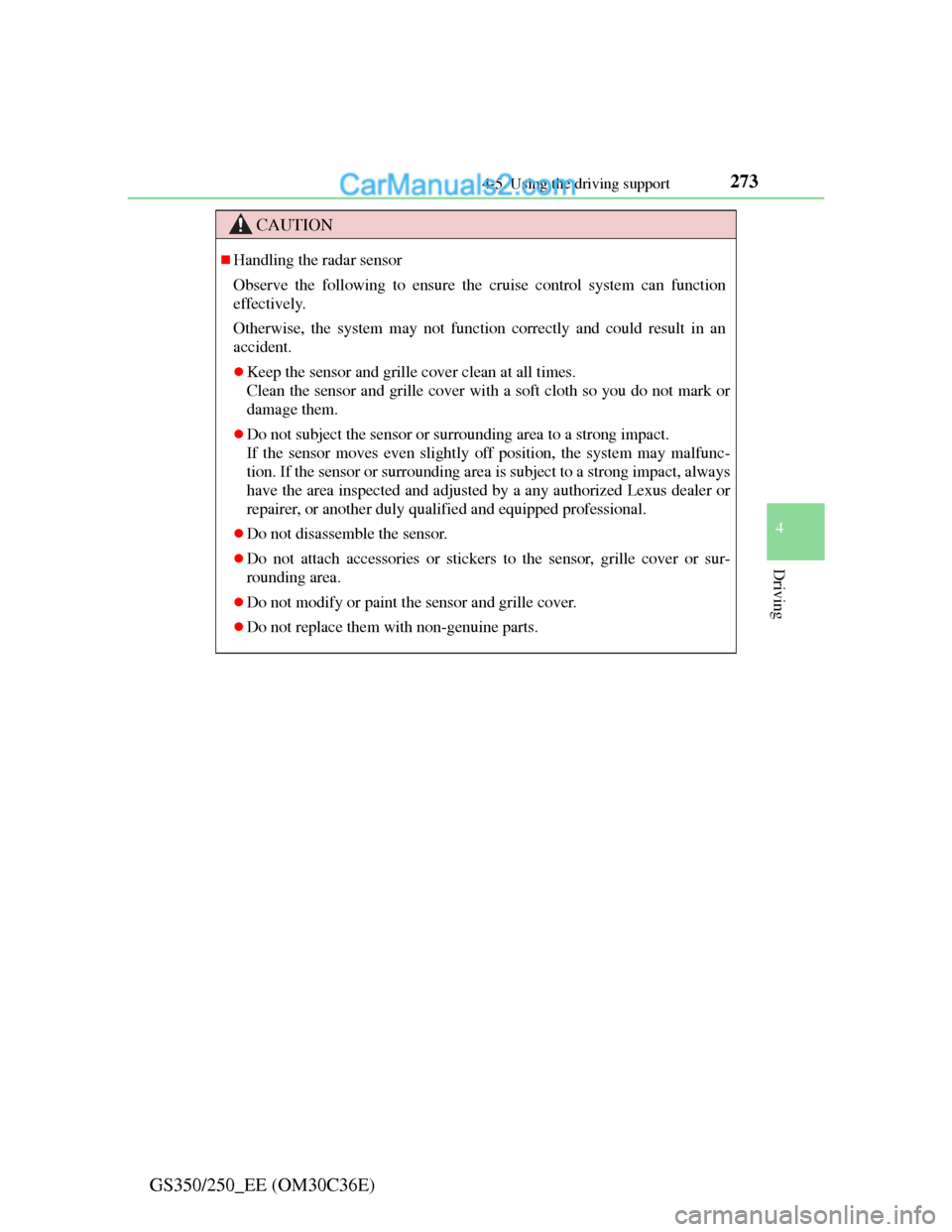
2734-5. Using the driving support
4
Driving
GS350/250_EE (OM30C36E)
CAUTION
Handling the radar sensor
Observe the following to ensure the cruise control system can function
effectively.
Otherwise, the system may not function correctly and could result in an
accident.
Keep the sensor and grille cover clean at all times.
Clean the sensor and grille cover with a soft cloth so you do not mark or
damage them.
Do not subject the sensor or surrounding area to a strong impact.
If the sensor moves even slightly off position, the system may malfunc-
tion. If the sensor or surrounding area is subject to a strong impact, always
have the area inspected and adjusted by a any authorized Lexus dealer or
repairer, or another duly qualified and equipped professional.
Do not disassemble the sensor.
Do not attach accessories or stickers to the sensor, grille cover or sur-
rounding area.
Do not modify or paint the sensor and grille cover.
Do not replace them with non-genuine parts.